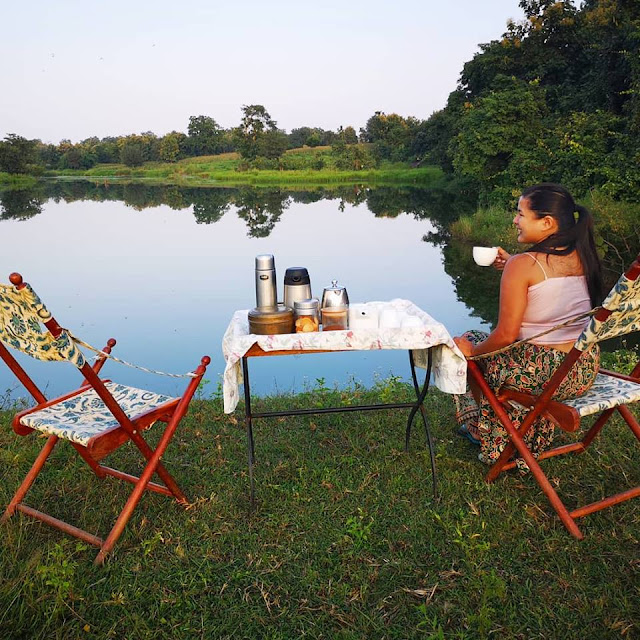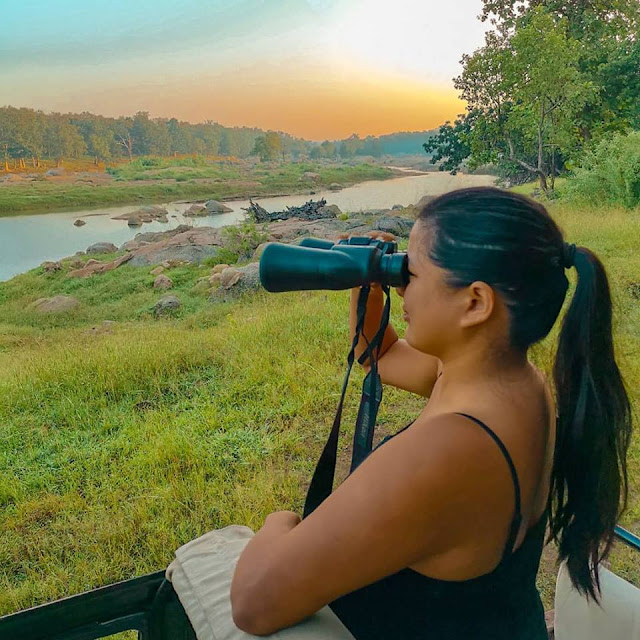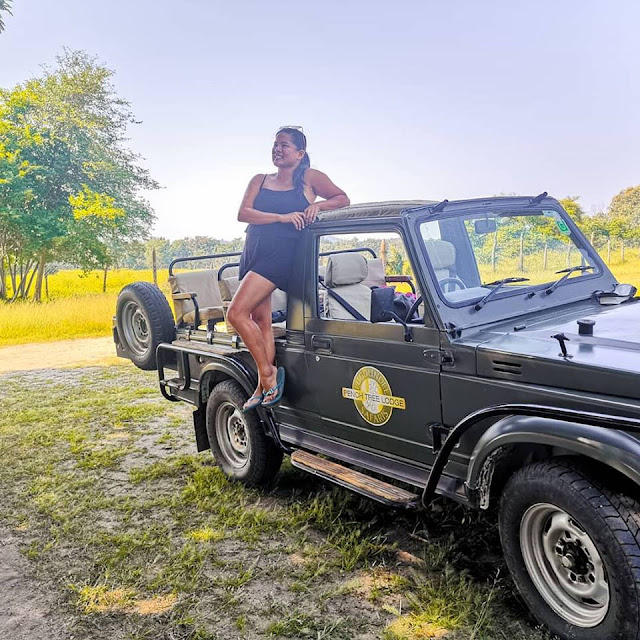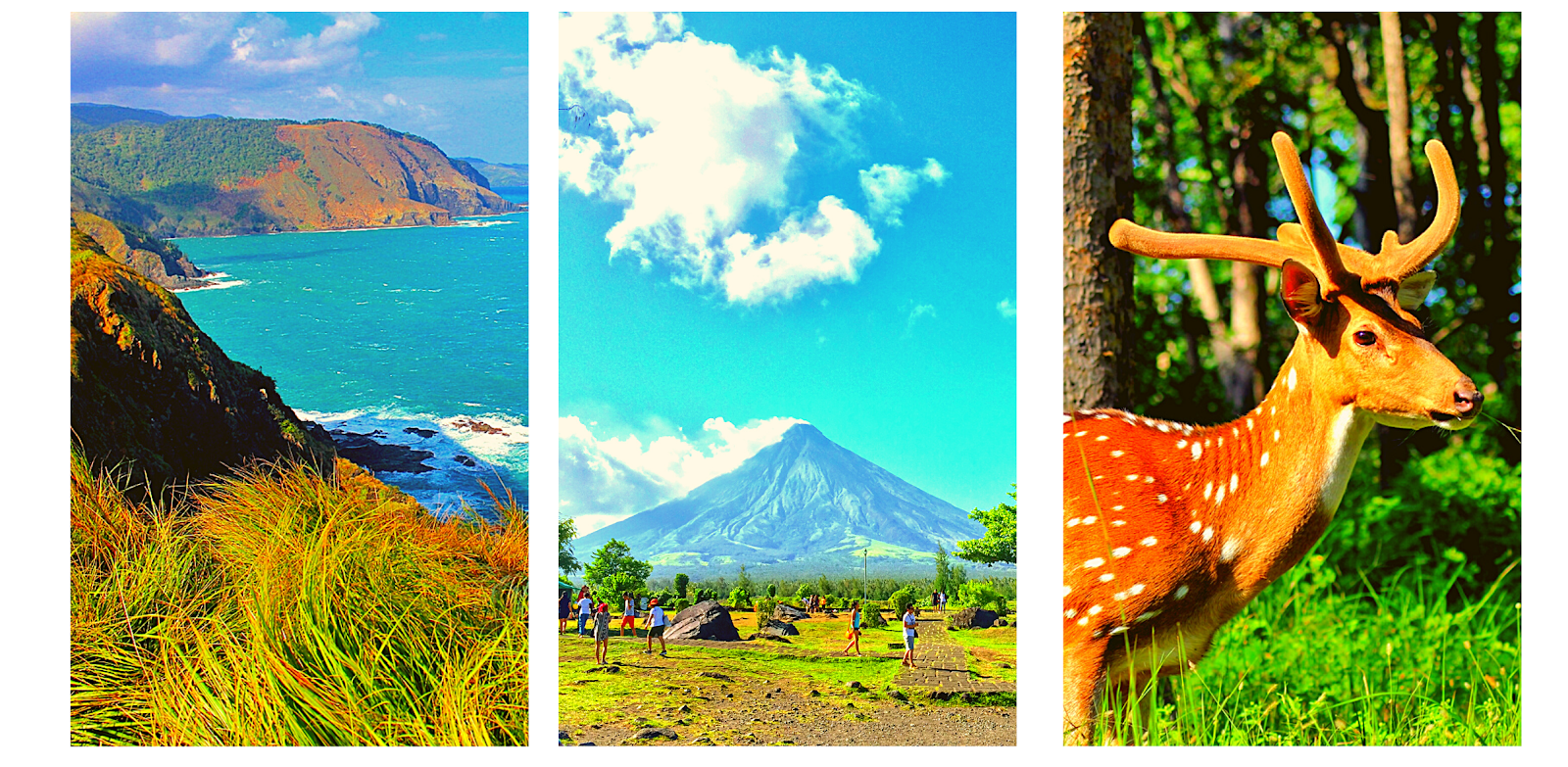Like leafing through the
pages of "Man-Eaters of Kumaon"
– Jim Corbett’s memoir of his experiences hunting man-eating Bengal tigers in
India’s Kumaon region, I find Chinmay’s tales of these wild beasts’ sightings
very engrossing. Unlike Corbett’s experiences, fortunately today in this part
of India, man has known better to let these animals roam freely.
Chinmay Deshpande is the
resident ‘naturalist’ of Pench Tree Lodge, the place where we were billeted. He
was briefing us on what to expect at the next day’s adventure with Pugdundee Safari at the Pench Tiger Reserve Natural Park in the state of Madhya Pradesh.
 |
| My safari-mate, Karla of KarlaroundtheWorld |
Sipping my Masala tea, my
mind wandered at the possibility of seeing my first tiger in the wild – as
different species of bird flew over us. While the sun glistens in golden hues, and
reflected beautifully over the glasslike pond, I muttered to myself “These is the great outdoors”.
 |
| The very knowledgeable Naturalist, Chinmay Deshpande |
I then
directed my eyes over the tree line in the far distance which encompasses the
buffer zone of the national park. I imagined that somewhere in that dense
forest roams the king of the jungle: the Bengal Tigers and its nemesis the
Indian Leopards, along with other wild animals.
Tiger-Spotting at Pench National Park
We started very early the
next day. By 4:30 am my friend Karla and I were already seated at the back of
Chinmay’s jeep. The cool wind and my anticipation of my first safari experience
gave me shudder all throughout our ride. We passed by corn fields stretching at
the edge where the landscape meets the slowly glowing skies, and rolled into
pockets of small villages.
We arrived at the gate of
the 758 square kilometer Pench National Park before 6 am. The park is closed every
monsoon months of July to September and opens again on October until June. It
was the first of October and Chinmay told us "You are the very first guests of this year's Safari season".
| A very chill Langur at the side of the road |
The chances of seeing the
evasive Bengali Tigers can go both ways "Tigers love to walk along the vehicle's path where we always see them
but since rain season just passed, they might still be deep in the forest.
November to February and the summer months starting March to May are the best
time to spot the Tigers" Chinmay adds.
| Sambar Deers |
While I am looking forward
to spotting many different animals, I admit that seeing the Bengali Tiger would
be the highlight of our Safari. I was measuring our odds of seeing tigers and
leopards the moment our vehicle rolled inside the national park. A few minutes
into it, we were greeted by a group of Chital or spotted deer huddled at the side of the road.
 |
| Still looking for tigers |
A few moments later our driver
stepped on the break and pointed something to us. My heart skipped a beat
expecting him to echo the words “Bengali
Tiger”, but instead he said “Bison”.
Looking like a cross-between of a buffalo and a bull, the bison appears
menacing seeing it a few meters away.
| We saw different bird species |
The rest of the morning
took us to every narrow trails around the approximately one-tenth of the
National Park’s area – where safaris are allowed, in search of the elusive
Bengali Tigers and Indian Leopards. We saw bunches of Langur
and Rhesus Macaques, Sambal Deer, gigantic spiders crawled up in giant webs,
wild boars, elephants, hyenas, jungle cats, porcupine, different birds (there
are 210 bird species in the park) and a jackal. The whole enchilada except the
tigers and leopards.
| The closest we came to a Tiger. Its Paw prints on the road |
We ended the safari without
catching a glimpse of the feared hunters of the jungles but I wasn’t
disappointed even for a bit. The reason mainly because of the informative lecture
of Chinmay about the habits of each wild animals and its surrounding habitat.
During our time inside the
Pench National Park, I have come to regard his being a naturalist a very
laudable one. If I would be given a chance, I shall certainly aspire becoming
one. By doing so it’ll make me further understand each animal and plant species.
Retiring to Pench Tree Lodge
Pench Tree Lodge is a
property owned by Pugdundee Safaris and sits just outside the buffer zone of
Pench Tiger Reserve Natural Park. It is 16 hectares of private forest with 6
spacious cottages and 6 tree houses built on stilts atop towering Mahua Trees.
Staying here felt like
being inside the National Park as sightings of wild boars, civets, spotted
deer, jungle cats and a multitude of birds and butterflies became a common
occurrence. The over-all tranquil vibe and surrounding set of nature really
made me fell in love with the wild life more.
On our last day here as I
stare at the trees, I saw vultures and other bird species gliding gracefully
against the pre-dusk skies. I heard myself think "how can one go mad at this beautiful world?” A world where even the
creatures described by Jim Corbett as “man-eaters”
brings so much excitement just at the mere idea of laying eyes on them. Grateful
for my first safari experience, I vow to join the fight against any act of
violence and form of hunting against these animals of the wild.
(Writer’s
note: A week after our trip, our friend Chinmay sent us a photograph of a Tiger
sighting inside Pench National Park)




















